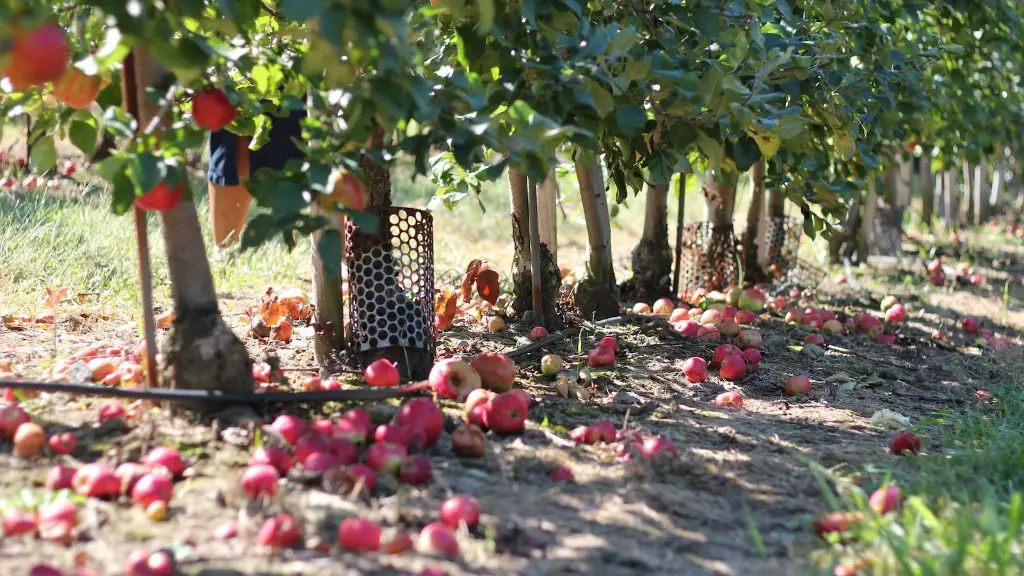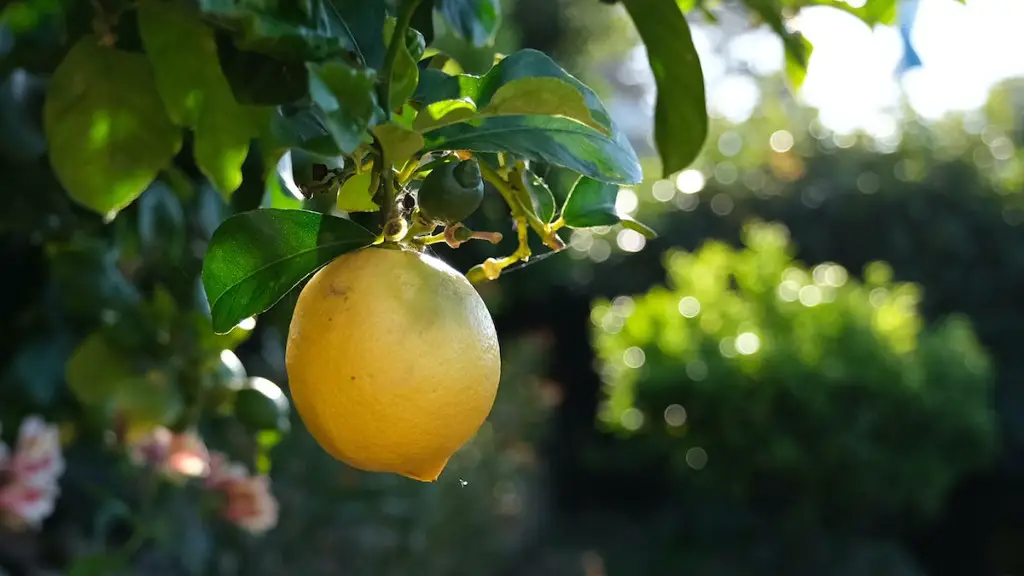To ensure an apple tree looks its best, one should bear in mind a few characteristics. Firstly, apples should be planted in well-drained soil, as any excessive free water can lead to root-rot. Additionally, apples need at least four hours of direct sunlight daily for optimal fruit formation. The ideal soil pH for apples is between 6.0 and 8.0. It’s also beneficial to fertilize the apple tree with a balanced, slow-release fertilizer at planting and the first few years afterwards.
Next, when planting an apple tree, one should dig a hole twice as wide and as deep as the root ball. It’s important to space apple trees at least ten feet apart with fifteen feet being ideal. After planting, the tree should promptly be watered, as this helps create a healthy root system. In addition, one should prune their apple tree every growing season to minimize insect and disease problems.
As the apple tree matures, its canopy shape should be maintained by pruning. It’s important to prune older apple trees annually in late winter because this encourages growth and reduces any opportunity for disease to move in. After pruning the tree, one should mulch around the tree with four to six inches of a porous material like shredded bark or wood chips. This will help reduce weeds and retain water in the soil.
Moreover, if any pests or disease problems arise during the growing season, one should take notice and tend to the tree quickly by using the right treatment. This can usually require water or soil-borne fungicides, insecticides, or removal of any infected leaves or parts of the tree. An apple tree can be remarkably resilient, however, without the right care, the fruit production can drastically decrease.
To summarize, apple trees should be planted in well-drained soil in direct sunlight, with a pH of 6.0-8.0. Trees should be spaced at least 10 feet apart with mulch layered around, and pruned annually in late winter with the right treatment administered if any pests or disease appears. Taking excellent care of an apple tree ensures it will look its best and yield delicious fruit.
Pruning
When pruning an apple tree, one should take into consideration the age, type and shape of the tree. Generally, pruning should begin soon after planting and can be done during the coarse of the growing season. Pruning should focus on removing shoots along with any dead, diseased or damaged branches. Young apple trees should be pruned to encourage optimium growth, while old apples should be pruned to minimize the risk of disease.
If the apple tree is too large, it’s best to prune the tree into an appropriate shape. This can give the tree an eye-pleasing aesthetically and provide more space for sunlight to enter. Proper pruning is an essential part to maintaining an apple tree’s shape and structure. It can also reduce the amount of fruit the tree will bear, and help avoid overburdening the tree with too much weight.
To enhance fruit and flower production, one should remove all suckers from the trunk and lower parts of the tree. These are branches that grow from the rootstock and should be removed in order to create a healthy tree. Additionally, when pruning an apple tree, one should avoid cutting branches too closely to the bud and should always leave healthy tissues afterwards.
Finally, pruning should also take into account the type of apple tree planted. Different varieties can require different types of pruning. For instance, standard apple trees require stronger pruning than dwarf or semi-dwarf varieties. Improper pruning can result in stunted growth and reduced fruit production. It’s important to research the specific variety and prune accordingly.
Soils
The soil is one of the most important elements for a successful apple tree. An apple tree should be planted in well-draining soil with a pH between 6.0 and 8.0. If the pH is not in this range it can lead to nutrient deficiencies, stunted growth and poor fruit production. Additionally, the soil should contain enough organic matter to ensure absorption of vital minerals and proper drainage. This can comprise of compost, manure, sand and other organic materials.
Organic matter is beneficial for both the tree and the soil, as it helps to reduce erosion, retain water, improve the physical structure of the soil, reduce wind and water damage, discourage compaction, increase the ability of the soil to hold nutrients, and promote oxygen flow to the roots. To get the most out of the organic matter, one should incorporate it into the planting site deep into the soil.
Furthermore, the soil should be loosened and deep sprayed with a garden hose before planting the tree. This helps to maximize oxygen flow and promote optimal root growth. In order to avoid nutrient deficiency, one should consult their local gardening center for the best way to fertilize the soil and any particular problems peculiar to their area. The soil should also be monitored for any signs of pests as this could impact the health of the apple tree.
It’s also possible to amend compacted soil in order to make it suitable for apples. This can be done by incorporating organic material and adding compost which will help to loosen the soil and make it easier for the tree to absorb water and nutrients. Apples thrive on good soil so it’s essential to create the best environment possible before planting one.
Watering
In order to ensure a healthy apple tree, one should be consistently watering the tree. This is best accomplished at the soil level rather than splashing the foliage, as this will help the tree take up the water more efficiently. Newly planted apple trees require more attention and should be watered until the soil is moist, but not waterlogged.
In addition, mature apple trees have different watering needs depending on the season and its surrounding environment. Generally, it’s best to water the tree every week during a dry spell and every two weeks during an average growing season. If temperatures suddenly rise, the tree should be watered more often. Additionally, water should be distributed evenly around the root zone of the tree, as this will help to promote a healthy root system and promote stronger growth.
Most importantly, the tree should be checked for dryness just before watering and should only be irrigated if the soil is dry. To check the dryness, one should simply poke the soil with a blunt object, such as a chopstick, and if it comes out dry, then the tree needs water. Additionally, if the tree needs more than a heavy watering, one should invest in a slow, trickle-type irrigation system specially tailored for apple trees.
It’s also important to remember that a healthy apple tree requires approximately 1-1.5 inches of water per week. If temperatures soar, more water may be necessary, however storm runoff from a heavy rain may reduce this necessity. Additionally, one should inspect their tree for any signs of drought stress and if warranted, water deeply to ensure the tree is well hydrated and healthy.
Fertilizer
Another important element in the maintenance of an apple tree is the use of fertilizer. Fertilizer should be employed with both precision and care and one should follow the instructions provided. This will help the tree become and remain healthy.
There are many types and amounts of fertilizer to choose from, so it’s important to select the one most suitable for the tree and the soil. Slow-release fertilizers are a great option for apple trees, as these can provide a steady and continuous supply of nutrients for a longer period of time. Additionally, if any significant issues have been identified with the soil, an appropriate fertilizer should be chosen to help eliminate the deficiency.
Before applying fertilizer to the tree, one should first inspect the foliage to see if any show signs of nutrient deficiency. If symptoms such as yellowing leaves are observed, the tree may need more fertilizer. Conversely, if any signs of burning foliage or vegetation appear, the amount of fertilizer should be reduced. Furthermore, deep watering with a slow-release fertilizer is essential to help the tree absorb nutrients, as well as increasing oxygen flow to the roots.
Apple tree fertilizer should also be applied after heavy pruning or in the aftermath of any damage due to freezing temperatures or pests. One should also take into account the age of the tree, as older trees may require less fertilizer than younger ones. To summarize, fertilizing an apple tree requires careful consideration and should be altered to suit the type, age, and condition of the tree.



